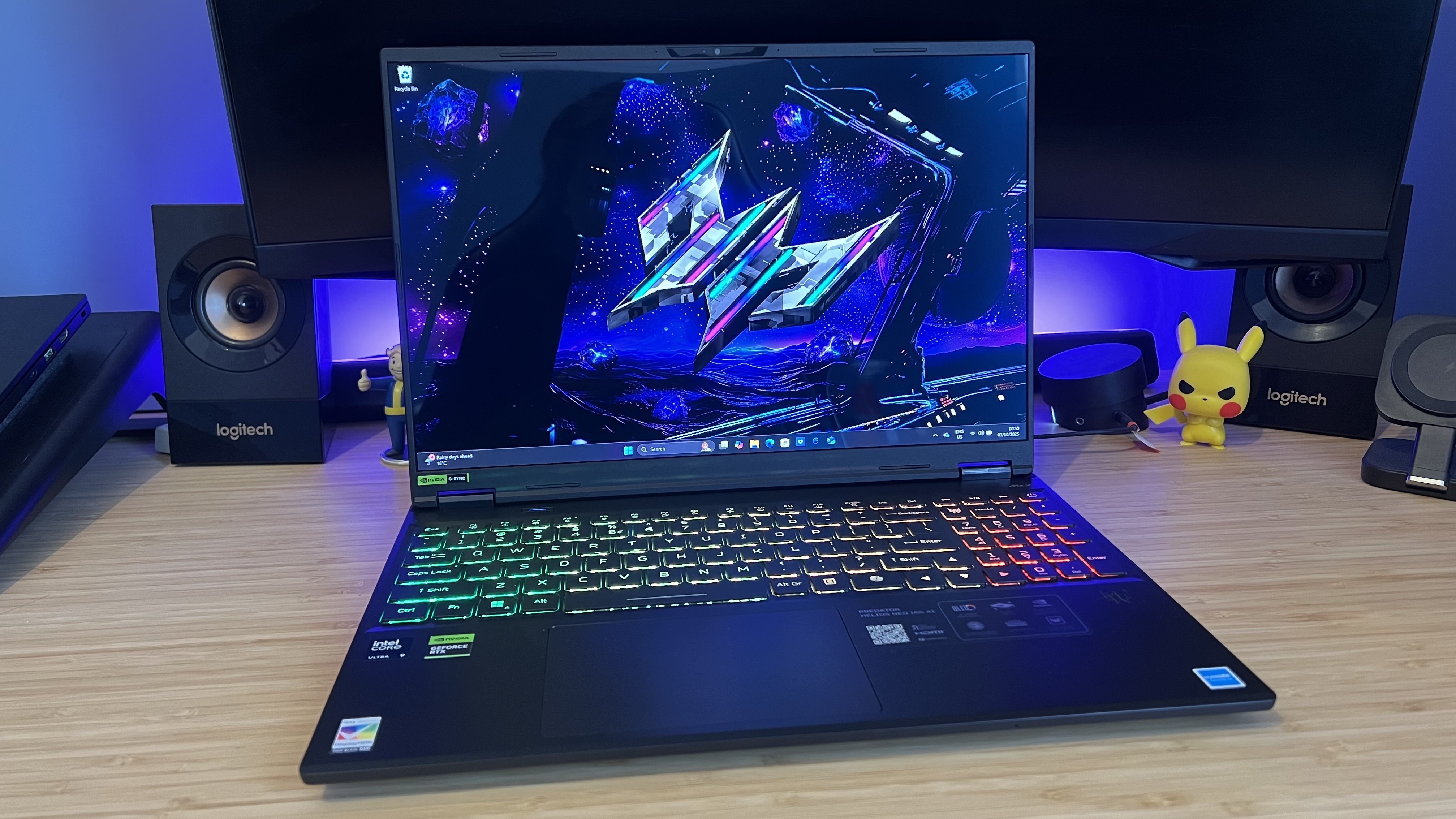GamesRadar+ Verdict
The Acer Predator Helios Neo 16S AI is an easy recommendation for anyone after an RTX 5070 Ti rig that wants to do it all. This is a fantastic all-rounder for those who want to dip in and out of both gaming and productivity - all on a blazing OLED panel.
Pros
- +
Better components than most in this price range
- +
Solid OLED display
- +
Slimline design
- +
Full sized keyboard
Cons
- -
Glossy panel
- -
Older ports
Why you can trust GamesRadar+
Back in my day you had to choose. Did you want a thick, chunky gaming laptop that could actually run your games, or a slimline one you can actually pick up? Kids today don't know the struggle, and I'm glad - because it means I can take the Acer Predator Helios Neo 16 AI around town while I work from coffee shops only to plug it in and enjoy some Doom: The Dark Ages when I get home.
This is the latest release in a relatively recent trend of the best gaming laptops. Machines no longer have to pad out their chassis' with thick cooling tech in order to run because more efficient components give us enough power in a much smaller form factor, and the Acer Predator Helios Neo 16 AI (breathe) is going all in.
It's far from the only rig of its kind. In fact, I've reviewed a whole wad of similarly designed gaming laptops this year. Both the Asus ROG Zephyrus G16 and Razer Blade 16 will run you a lot more cash, though.
| Header Cell - Column 0 | Tested | Also Available |
|---|---|---|
Price | $2,299 | $1,599.99 - $2,599 |
Display | 16-inch QHD+ OLED at 240Hz | 16-inch QHD+ OLED at 165Hz |
Processor | Intel Core Ultra 9 275HX | Intel Core Ultra 7 255HX | Intel Core Ultra 5 235HX |
GPU | Nvidia RTX 5070 Ti | RTX 5060 | RTX 5070 |
RAM | 32GB | 64GB |
Storage | 2TB SSD | 1TB SSD | 4TB SSD |
Connectivity | WiFi 6E, Bluetooth | - |
Ports | 1x USB Type-A 3.2 Gen 1, 2x USB Type-A 3.2 Gen 2, 1x USB Type-C 3.2 Gen 2 (Power Delivery, DisplayPort), 1x USB Type-C 3.2 Gen 2 (Thunderbolt 4), 1x HDMI 2.1, MicroSD, 3.5mm audio, 1x RJ45 | - |
Dimensions | 14.05 x 10.85 x 0.79 inches | - |
Weight | 2.3kg (5.07lbs) | - |
Configurations
My review unit sits near the top of the Acer Predator Helios Neo 16S AI configuration roster, with an Intel Core Ultra 9 275HX processor, RTX 5070 Ti graphics card, 32GB RAM, and 240Hz OLED display. It's that 2TB SSD that contributes to the larger $2,299 price tag, though, as it's a little more difficult to get your hands on. Halving it down to 1TB will see you scoring the same specs for $1,899.99 right now.
That's a fantastic starting position for an RTX 5070 Ti gaming laptop, especially considering most lower mid-range configuration options tend to cap out at the RTX 5070. That's the case for the Lenovo Legion 5 Gen 10 but also the vastly more expensive Razer Blade 14. Acer wants you to have the full 12GB to play with here, though.
We've got a little more breathing room for higher framerates, as well as a solid range of cheaper specs should you wish to keep that price closer to $1,600. If you want, you can go all the way up to 64GB RAM and a 4TB SSD - but you'd need to really prioritize that storage to pick up an RTX 5070 Ti machine for $2,599.
Design
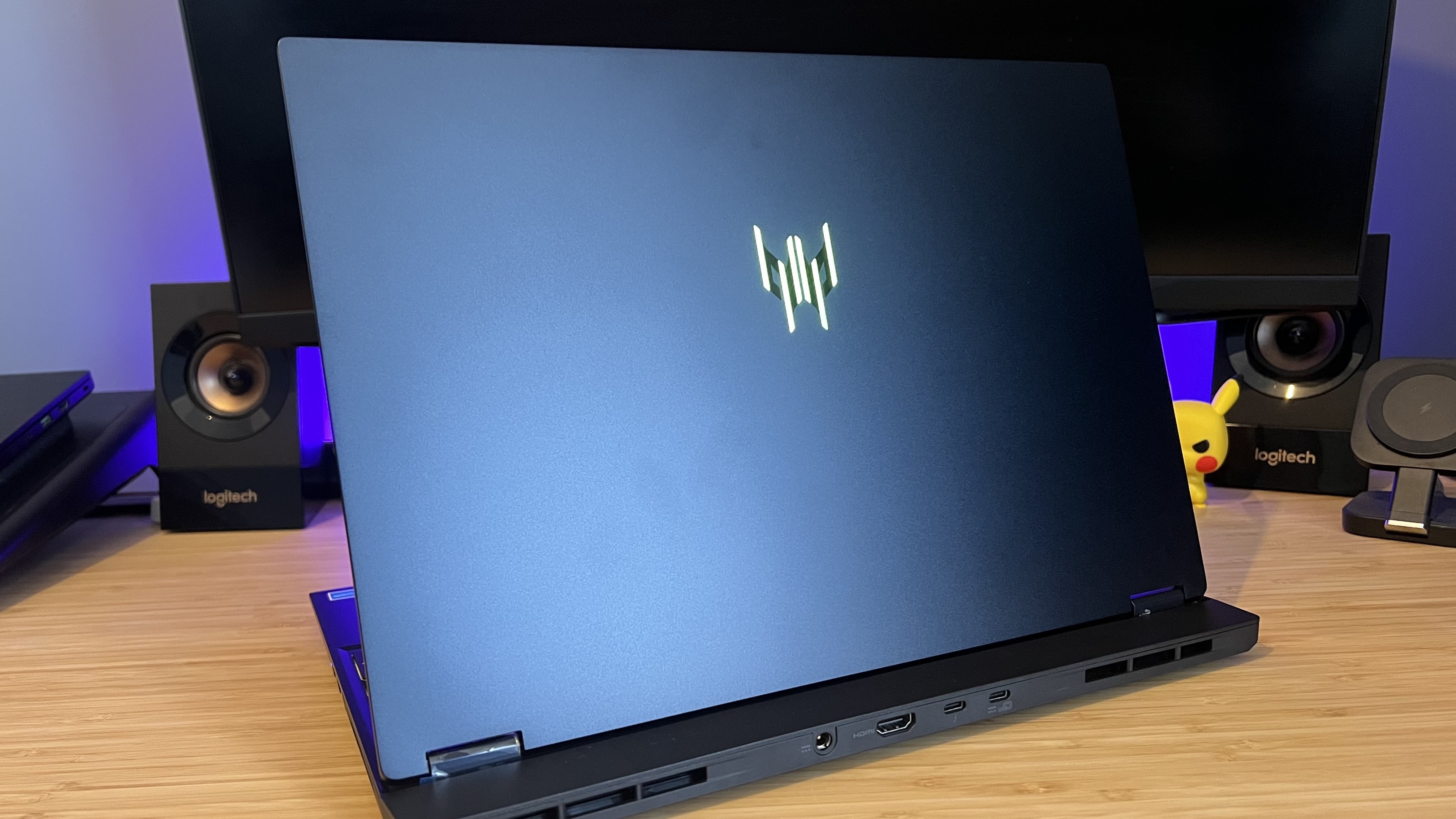
Like many slimmer machines, the Predator wants to fly under the radar. This is a matte black machine with a very slight wedge shape and a subtle, understated logo situation. The only branding is a hidden logo towards the vents and a glossed Predator icon in the center of the lid. If you didn't spot the jutting cooling shelf, you may easily mistake this machine for a regular business laptop.
Weekly digests, tales from the communities you love, and more
It's got the waistline for the job anyway. At 2.3kg, it's lighter than the similarly-styled Alienware 16X Aurora as well as the slightly cheaper Lenovo Legion 5 Gen 10. At its thinnest point (right at the front lip), it's also much skinnier, measuring at just 0.64-inches. That's the same thickness as the Razer Blade 14, the luxury brand's most compact machine to date.
It's built to travel particularly easily, though the aforementioned cooling shelf could prove tricky if you have a particularly small backpack. It is, however, made from a slightly thinner material than you'll find on more premium models. That's not to say I have concerns, in fact everything feels solid with no creaks and only light flexing to the main deck - less, even, than I found on the keyboard of the HP Omen Max 16, and that's my favorite release of the year. There are build quality sacrifices present here, compared to the likes of the best Asus gaming laptops, for example.
Display
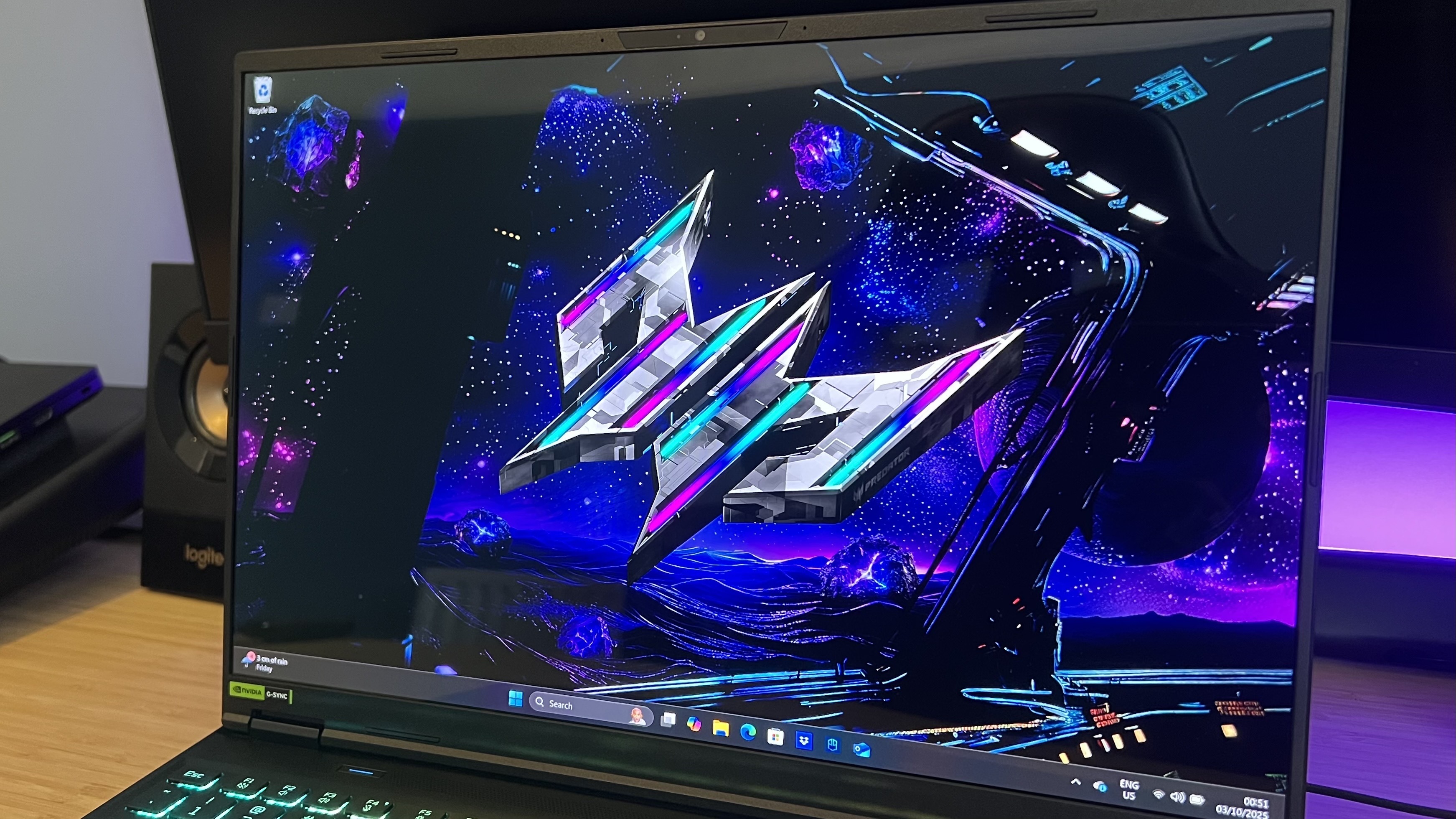
OLED displays are making their way to the mainstream this year and newer releases are using these panels in far more affordable rigs than ever before. While the Predator Helios Neo 16S AI isn't the cheapest gaming laptop with an OLED display right now, that would go to the Gigabyte Aero X16 with the Lenovo Legion 5 hot on its tail. However, this panel is built a little different.
It's got fantastic color reproduction, with super vibrant highlights and excellent detail in darker scenes. Contrast is super crisp, with inky blacks and colors popping across the scene. Not only that, but everything's running in full QHD+ 240Hz quality you'd expect from a mid-range price tag.
There is a little glare. This is a glossy panel, but it's nowhere near as offensive as the Legion 5 or HP Omen Transcend 14. I spent far more time marveling at the details than I did inspecting my own face.
Ports
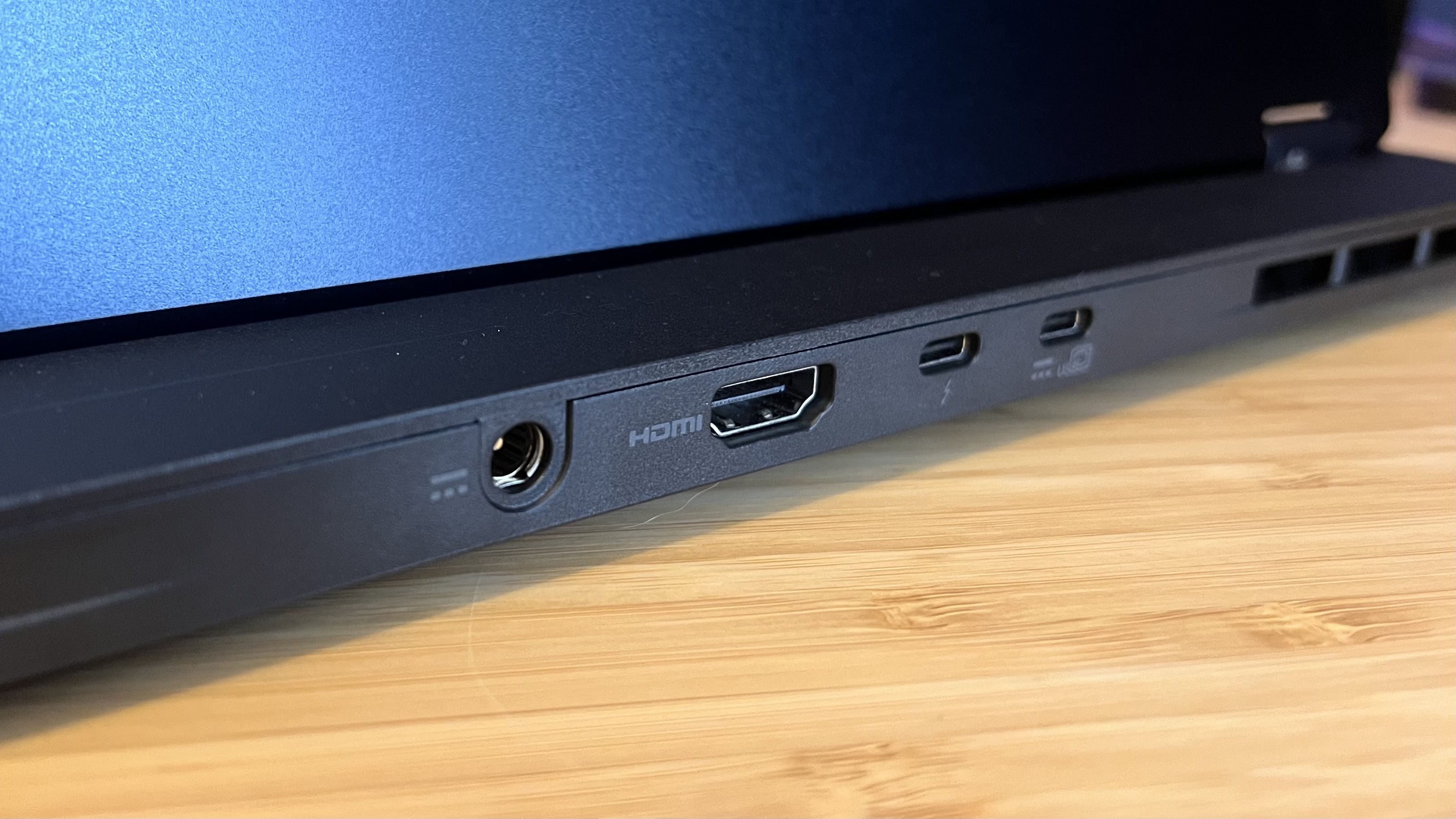
With three USB-As and two USB-Cs (including a Thunderbolt 4) spread across the sides and rear, you're well stocked for accessory connections and easy charging. You do have one older Gen 1 USB-A port in here, but there's plenty of speed elsewhere. More expensive machines can also upgrade that Thunderbolt 4 to the newer Thunderbolt 5, but the move only makes sense if you want to output at multiple high-speed 4K monitors and the RTX 5070 Ti would struggle to stay smooth anyway.
Having these USB-A ports split across the sides could be frustrating if you're using wired accessories. Having these connections on the side can often create a spider effect, with cables strewn across the desk and interrupting your mouse hand. Wireless receivers will keep that sprawl down, though, and you've still got rear-mounted USB-Cs to keep some cords out of the way.
Keyboard and trackpad
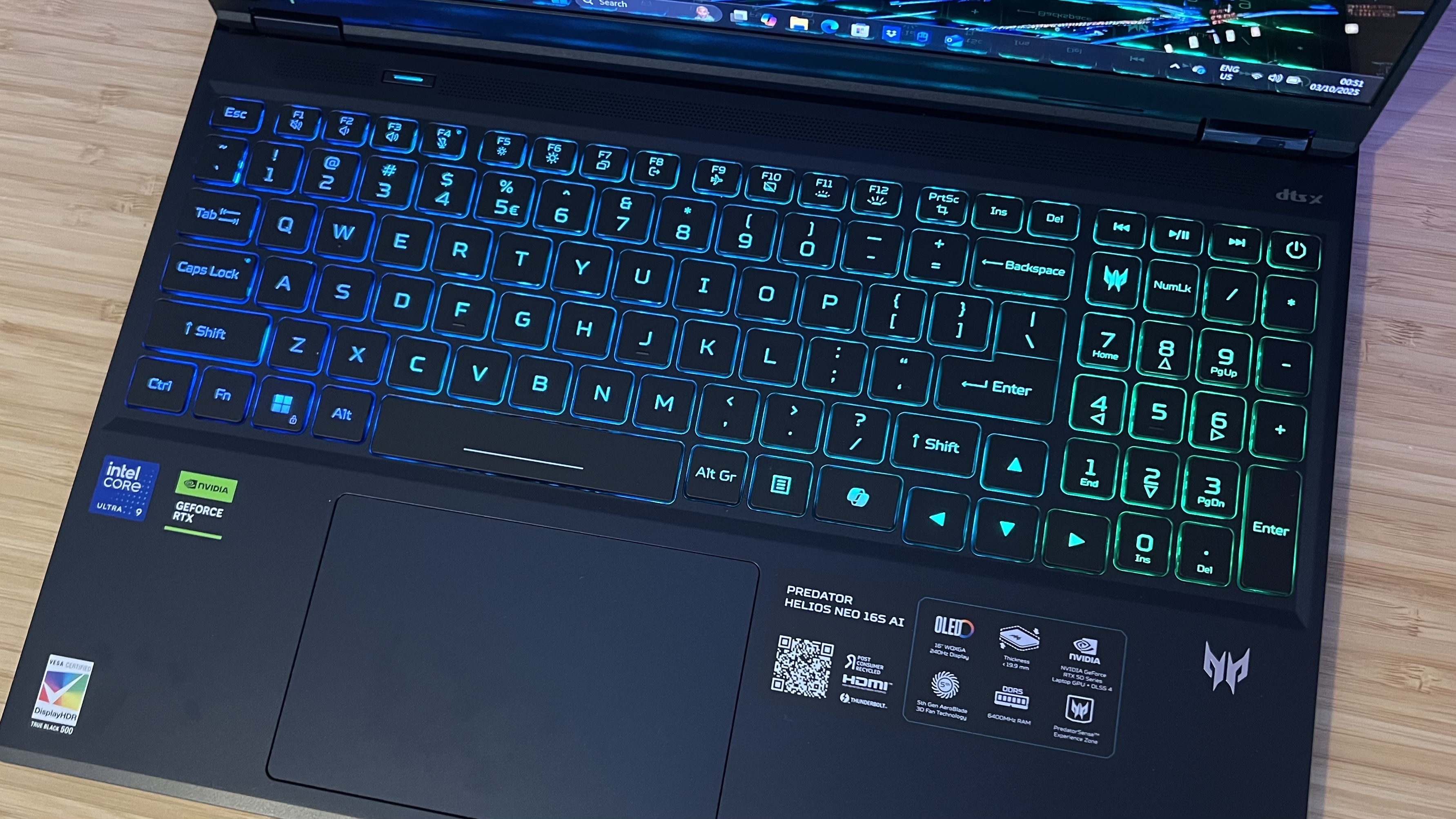
The Acer Predator Helios Neo 16S AI has a softer but still satisfying keyboard. A 1.5mm key travel keeps things suitably springy, with a tactile bounce to return to full height and a nicely cushioned landing spot for comfortable typing over longer sessions. You've also got a bold set of RGB LEDs under the keys themselves.
Full-sized arrow keys and a decently sized number pad round this offering out particularly well - you'd be surprised how much you can spend on a gaming laptop only to be faced with half-sized keys.
The trackpad isn't quite as solid as the keyboard it accompanies. The plastic construction feels a little softer than I'd like, and especially compared to the glass pads you'll find in more premium models. However, for casual navigation it holds up well, offering a smooth glide and responsive tap.
Performance
The Acer Predator Helios Neo 16S AI certainly benefits from moving beyond the RTX 5070 cap that seems to be hampering other releases. The RTX 5070 Ti model I tested comes in much cheaper than its competitors in this pool, but still manages to hold its own in the benchmarks.
It's a little behind the chunkier Asus ROG Strix G16 (RTX 5070) in Fire Strike, but easily beats it and the skinnier Asus ROG Zephyrus G14 (RTX 5080) in Time Spy. Steel Nomad is a tougher task, where the RTX 5070 Ti Acer naturally falls under the higher-class card.
1080p in-game benchmarks really let the Predator open up. It manages to top the charts for Shadow of the Tomb Raider framerates, but its Cyberpunk 2077 and Horizon Zero Dawn Remastered benchmarks are more representative of the more modern gameplay experience. I was consistently well above 60fps even at the highest settings in both titles here.
The Helios even beat the RTX 5080 inside slimmer Asus ROG Zephyrus machines. The real test comes when that resolution is cranked up, though.
In QHD, the Predator starts to fall under the slimmer machines a little more regularly, though it still runs slightly faster than the RTX 5080 Zephyrus G16 in Horizon Zero Dawn: Remastered. Still, you're going to be struggling to keep your head above 60fps in more demanding games at highest settings with an RTX 5070 system, and the RTX 5070 Ti inside gets us just a little closer.
Cyberpunk 2077 averages at 51fps when pushed in full RT Ultra, but new DLSS features can also bump that up to 162fps if you want to turn on 4x Multi Frame Generation.
Should you buy the Acer Predator Helios Neo 16S AI?
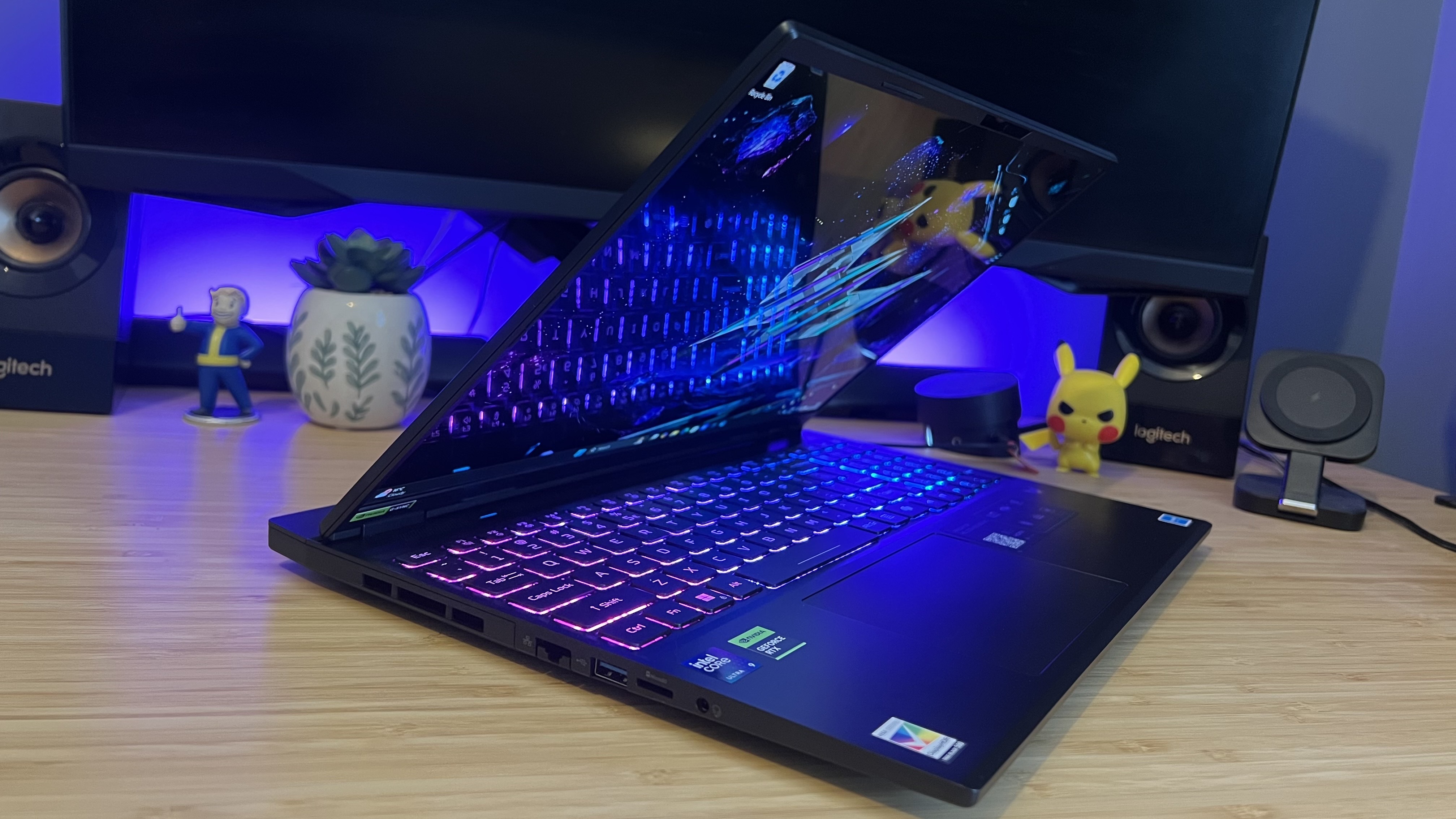
The Acer Predator Helios Neo 16S AI is a sturdy gaming laptop well worthy of its lower mid-range price tag. Its fantastic OLED display beats other cheaper panels on the market, though doesn't quite give the Razer Blade 16 anything to worry about, and its push up to the RTX 5070 Ti certainly serves it well in performance as well.
A slimmer design that still maintains power is always going to win in my books, so while you're still not going to be hitting 60fps in RT Ultra on Cyberpunk QHD+ here you're still getting an excellent price to performance ratio.
If you want to spend a little less, the Lenovo Legion 5 Gen 10 skews slightly towards better value, though you're dropping the extra power from your GPU. If you don't want to sacrifice high-end components or build materials, I'd check out the Asus ROG Zephyrus G16 or Razer Blade 16 instead.
How I tested the Acer Predator Helios Neo 16S AI
I used the Acer Predator Helios Neo 16S AI for work and play over a period of one week, using the device as I would my usual gaming laptop. I worked solely from the laptop itself for two days, spending a few more days connected to a separate monitor system. I only ever played using the laptop itself, rather than another screen.
I tested using Doom: The Dark Ages and Spiritfarer from my current backlog, but also tested directly in Shadow of the Tomb Raider, Total War: Three Kingdoms, Horizon Zero Dawn Remastered, and Cyberpunk 2077 as well as 3D Mark's Time Spy, Fire Strike, and Steel Nomad.
For more information on how we test gaming laptops, check out the full GamesRadar+ Hardware Policy.
I'm also rounding up all the best Razer laptops and best Alienware laptops on the market. For something a little more sturdy, though, take a look at the best gaming PCs we've tested.

Managing Editor of Hardware at GamesRadar+, I originally landed in hardware at our sister site TechRadar before moving over to GamesRadar. In between, I've written for Tom’s Guide, Wireframe, The Indie Game Website and That Video Game Blog, covering everything from the PS5 launch to the Apple Pencil. Now, i'm focused on Nintendo Switch, gaming laptops (and the keyboards, headsets and mice that come with them), PS5, and trying to find the perfect projector.
You must confirm your public display name before commenting
Please logout and then login again, you will then be prompted to enter your display name.
